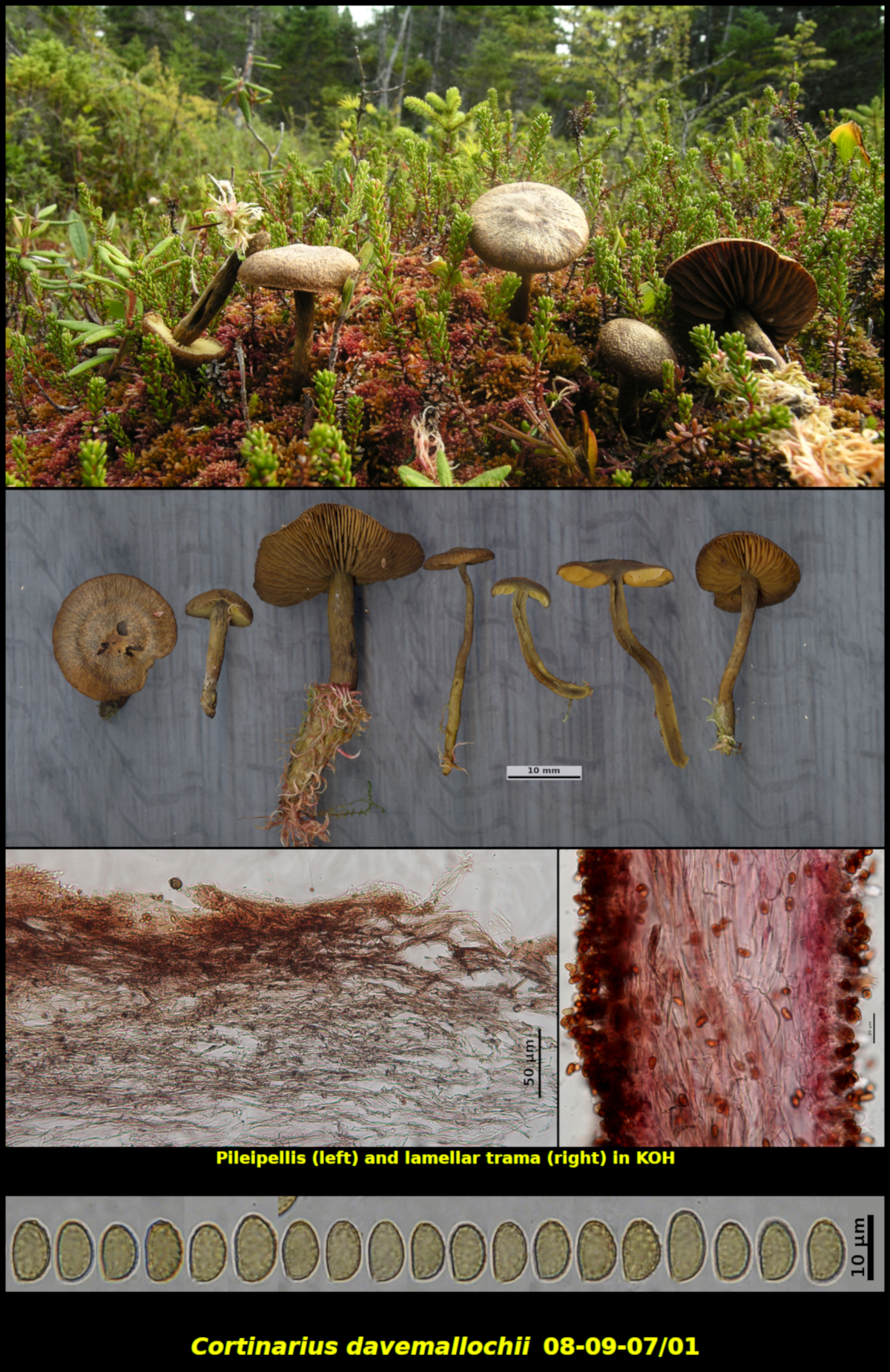Fleshy Fungi of New Brunswick >>
Cortinarius davemallochii
Cortinarius davemallochii Ammirati, Niskanen & Liimat.

Scattered to gregarious in Sphagnum carpet in boggy area under stunted Picea mariana and Larix laricina – MacPherson Point Protected Natural Area, Little Lepreau, New Brunswick (08-09-07/01).
Pileus convex at first, expanding to more broadly so at maturity and then finally more concave-depressed, with a low umbo or without an umbo, dry, glabrous, appearing somewhat radially rugulose in the field, finely and densely appressed-scaly when young and retaining the scaliness at maturity but with this feature less apparent, with scales Pale yellow to Greyish yellow (Methuen 4AB3) and dominating the pileus colour when young, later with scales separating to reveal patches of a Reddish brown (9F6) ground colour that becomes increasingly revealed during maturation, black in 5% KOH, 24-50 mm in diameter. Stipe equal or slightly enlarged at the base, dry, covered at first with a layer of Greyish yellow (3B3-4) hyphae that characterize its colour but with this layer thinning in age or on handling to reveal a Reddish brown (8F5) ground colour, hollow at the centre, 35-70 X 2-7 mm. Lamellae Greyish yellow (3B4) to slightly more yellow at first, darkening to Bright yellow to Greyish yellow (4AB4) as the spores begin to mature, later more rusty, red-brown in 5% KOH, subclose, adnexed, not marginate. Cortina Pale yellow (3A3), evanescent. Flesh Olive (3EF4) in the pileus and upper part of the stipe, Pale yellow to Greyish yellow toward the surface in the lower part of the stipe, with a pronounced but nondescript mushroom odour and taste.
Basidiospores ellipsoidal, with an evenly rounded apex, rather coarsely roughened, 7.9-10.7 X 5.2-6.2 μm, Q = 1.45-1.85 (average[27]: 9.0 X 5.6 μm, D/d = 1.60). Pileipellis with a thin smooth epicutis that remains hyaline in 3% KOH and a subcutis of larger hyphae staining brown in 3% KOH. Lamellar trama conspicuously red in 3% KOH.
Identifying the species of Cortinarius subgenus Dermocybe growing among Sphagnum mosses is difficult and perhaps not thoroughly resolved. Cortinarius davemallochii was described from New Brunswick and some collections, including the holotype and 08-09-07/01, have been sequenced. It appears to be very similar to C. huronensis, described from similar habitats, from which it differs in having its pileus turning dark brown to black in 3% KOH rather than red. Cortinarius chrysolitus, another similar species occuring among Sphagnum species differs in having lamellae that may be slightly greenish and having a more roughened pileus. The pileus of C. davemallochii, when young, is covered with short appressed scales but is otherwise smooth. When mounted in KOH the tissues of the pileus and lamellae show a greater or lesser amount of purple. The tissues may also enclose masses or orange crystals that turn red to purple in KOH. The basidiospores are rather narrow, with an average Q (aspect ratio) of 1.6 or more.
Cortinarius davemallochii is found in partially oligotrophic bogs but ones in which there is probably at least some directional flow of water. It appears to be common in coastal bogs along the Bay of Fundy, characterized by the presence of Rubus chamaemorus and Empetrum nigrum as well as Picea mariana and Larix laricina.Photograph: D. Malloch (08-09-07/01).